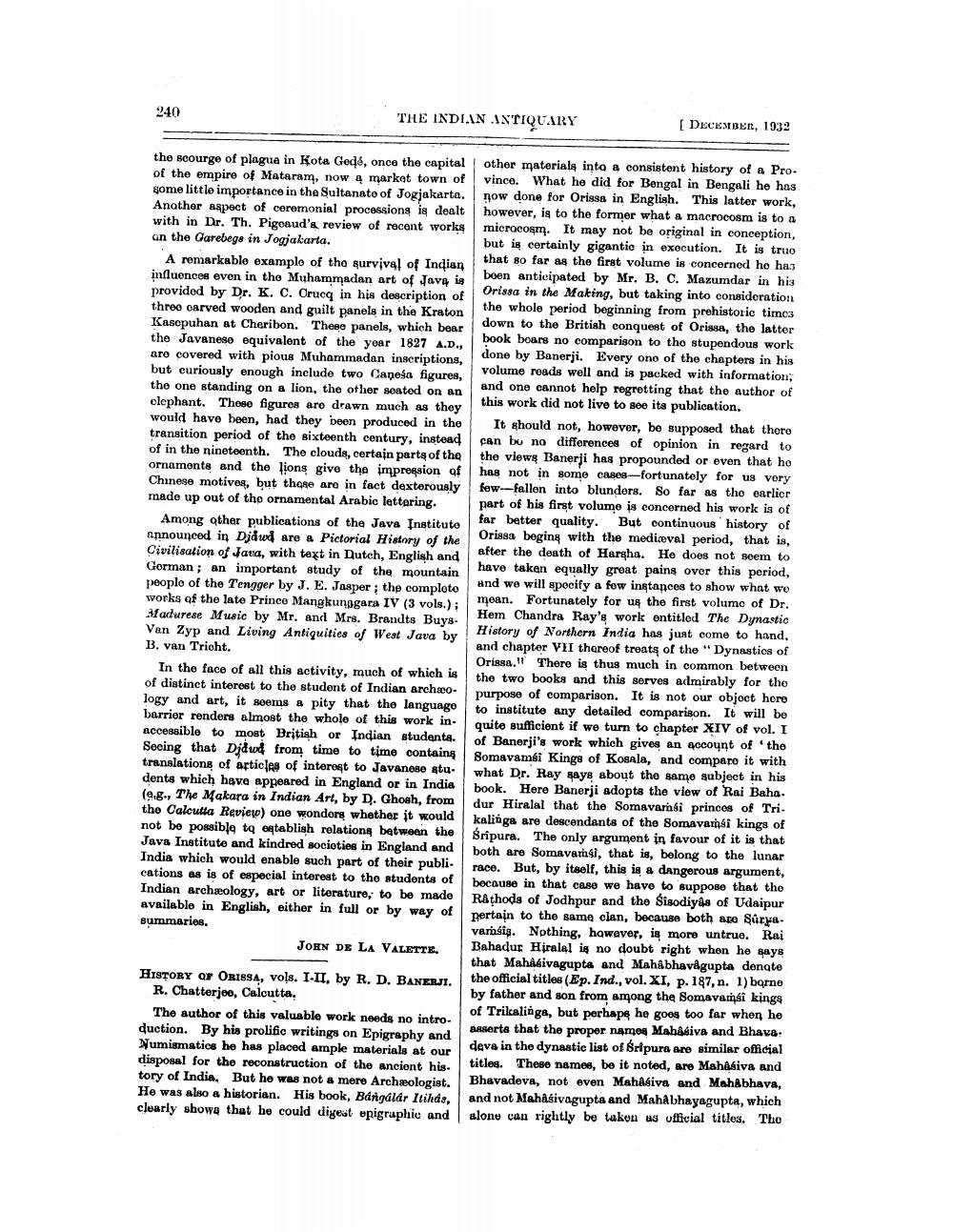________________
240
THE INDIAN ANTIQUARY
the scourge of plagua in Kota Gedé, once the capital of the empire of Mataram, now a market town of some little importance in the Sultanate of Jogjakarta. Another aspect of ceremonial processions is dealt with in Dr. Th. Pigeaud's review of recent works an the Garebegs in Jogjakarta.
A remarkable example of the survival of Indian influences even in the Muhammadan art of Java is provided by Dr. K. C. Crucq in his description of three carved wooden and guilt panels in the Kraton Kasepuhan at Cheribon. These panels, which bear the Javanese equivalent of the year 1827 A.D., are covered with pious Muhammadan inscriptions, but curiously enough include two Capeśa figures, the one standing on a lion, the other seated on an elephant. These figures are drawn much as they would have been, had they been produced in the transition period of the sixteenth century, instead of in the nineteenth. The clouds, certain parts of the ornaments and the lions give the impression of Chinese motives, but these are in fact dexterously made up out of the ornamental Arabic lettering.
Among other publications of the Java Institute announced in Didwd are a Pictorial History of the Civilisation of Java, with text in Dutch, English and Gorman; an important study of the mountain people of the Tengger by J. E. Jasper; the complete works of the late Prince Mangkunggara IV (3 vols.); Madurese Music by Mr. and Mrs. Brandts BuysVan Zyp and Living Antiquities of West Java by B. van Tricht.
In the face of all this activity, much of which is of distinct interest to the student of Indian archæology and art, it seems a pity that the language barrier renders almost the whole of this work inaccessible to most British or Indian students. Seeing that Djdud from time to time contains translations of articles of interest to Javanese stu. dents which have appeared in England or in India (9.g., The Makara in Indian Art, by D. Ghosh, from the Calcutta Review) one wonders whether it would not be possible to establish relations between the Java Institute and kindred societies in England and India which would enable such part of their publications as is of especial interest to the students of Indian archæology, art or literature, to be made available in English, either in full or by way of summaries.
JOHN DE LA VALETTE.
HISTORY OF ORISSA, vols. I-II, by R. D. BANERJI. R. Chatterjee, Calcutta,
The author of this valuable work needs no introduction. By his prolific writings on Epigraphy and Numismatics he has placed ample materials at our disposal for the reconstruction of the ancient his tory of India. But he was not a mere Archeologist. He was also a historian. His book, Bángálár Itihas, clearly shows that he could digest epigraphic and
[DECEMBER, 1932
other materials into a consistent history of a Province. What he did for Bengal in Bengali he has now done for Orissa in English. This latter work, however, is to the former what a macrocosm is to a microcosm. It may not be original in conception, but is certainly gigantic in execution. It is truo that so far as the first volume is concerned he has been anticipated by Mr. B. C. Mazumdar in his Orissa in the Making, but taking into consideration the whole period beginning from prehistoric times down to the British conquest of Orissa, the latter book boars no comparison to the stupendous work done by Banerji. Every one of the chapters in his volume roads well and is packed with information; and one cannot help regretting that the author of this work did not live to see its publication.
It should not, however, be supposed that there can be no differences of opinion in regard to the views Banerji has propounded or even that ho has not in some cases-fortunately for us very few-fallen into blunders. So far as the earlier part of his first volume is concerned his work is of far better quality. But continuous history of Orissa begins with the medieval period, that is, after the death of Harsha. He does not seem to have taken equally great pains over this period, and we will specify a few instances to show what we mean. Fortunately for us the first volume of Dr. Hem Chandra Ray's work entitled The Dynastic History of Northern India has just come to hand, and chapter VII thereof treats of the "Dynastics of Orissa." There is thus much in common between the two books and this serves admirably for the purpose of comparison. It is not our object here to institute any detailed comparison. It will be quite sufficient if we turn to chapter XIV of vol. I of Banerji's work which gives an account of the Somavamsi Kings of Kosala, and compare it with what Dr. Ray says about the same subject in his book. Here Banerji adopts the view of Rai Baha. kalinga are descendants of the Somavami kings of dur Hiralal that the Somavarsi princes of Triśripura. The only argument in favour of it is that both are Somavamsi, that is, belong to the lunar race. But, by itself, this is a dangerous argument, Rathods of Jodhpur and the Sisodiyas of Udaipur because in that case we have to suppose that the pertain to the same clan, because both are Surya. varsis. Nothing, however, is more untrue. Rai Bahadur Hiralal is no doubt right when he says that Mahasivagupta and Mahâbhavågupta denate the official titles (Ep. Ind., vol. XI, p. 187, n. 1) borne by father and son from among the Somavamsî kings of Trikalinga, but perhaps he goes too far when he asserts that the proper names Mahasiva and Bhava deva in the dynastic list of Sripura are similar official titles. These names, be it noted, are Mahasiva and Bhavadeva, not even Mahasiva and Mahabhava, and not Mahasivagupta and Mahabhayagupta, which alone can rightly be taken as official titles. The




